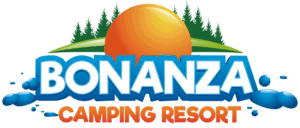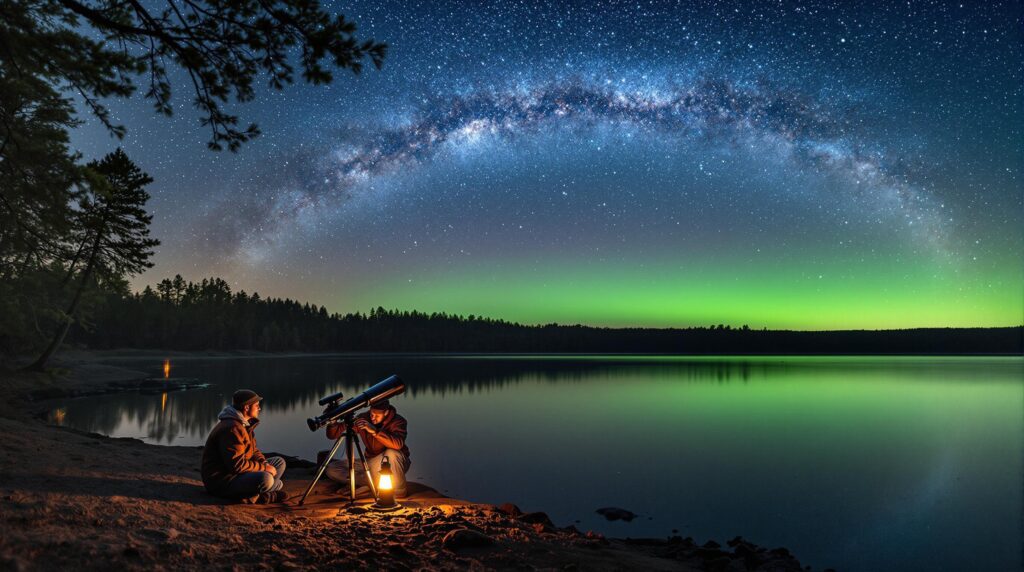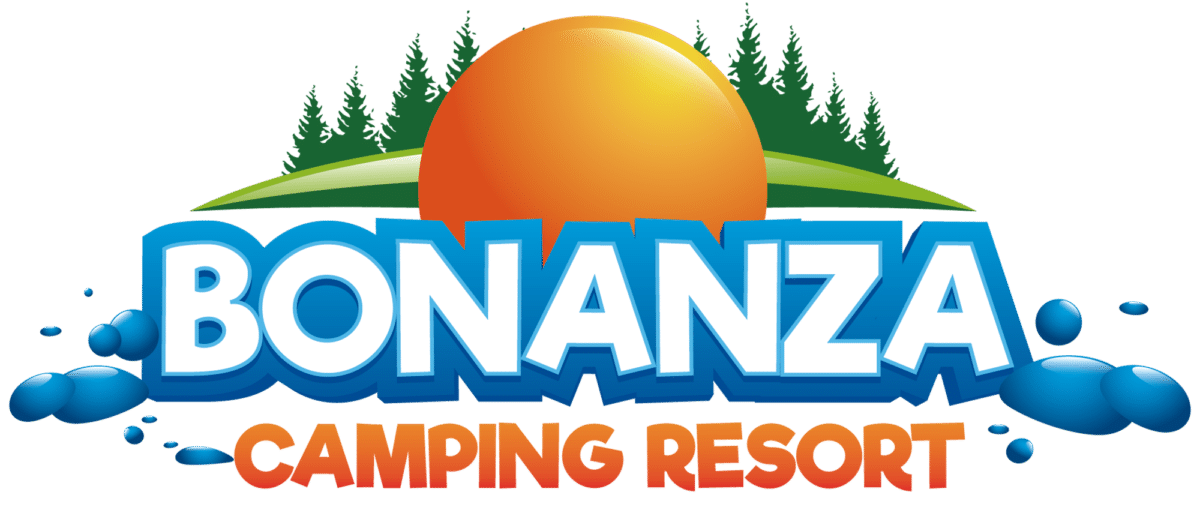Crickets fade, campfires dim…and suddenly Orion pops like a backstage spotlight over Mirror Lake. This spring, the night sky is the main attraction just five miles from your Bonanza campsite—no long drives, no pricey tickets, just galaxies on tap.
Key Takeaways
Mirror Lake’s dark horizon means beginners and seasoned stargazers can see more in one hour than most suburbs reveal in a month. Tuck these quick facts into your back pocket before you toss a single sweatshirt or lens wipe into the daypack, and you’ll glide through the gate like a pro. A little forethought ensures the only surprises you encounter are the shooting stars overhead.
• Mirror Lake State Park is only a 10-minute, 5-mile trip from Bonanza Camping Resort.
• Big sky shows:
• March 25, 2024 – lunar eclipse
• April 8, 2024 – partial solar eclipse (use safe eye filters)
• April 22–23, 2024 – Lyrids meteor shower
• May 6–7, 2024 – Eta Aquarids meteor shower
• August 10, 2024 – Universe in the Park talk and telescopes at 8:30 p.m.
• June 28, 2025 – next Universe in the Park night
• Buy a Wisconsin State Park vehicle sticker online to get through the gate fast.
• Leave camp around 7:45 p.m. to park, walk in, and find a seat before dark.
• Pack layers, red-light flashlights, binoculars, bug spray, water, and snacks.
• Keep lights dim and voices low so everyone’s eyes adjust to the dark.
• Weather changes quickly; check the forecast and bring a cloth to wipe dew from lenses.
• Accessible paths, stroller-friendly walks, and two ADA parking spots make the area easy for all ages.
Circle 8:30 p.m. on your calendar: Universe in the Park telescopes land here August 10, with a kid-friendly space talk that morphs into “wow” views when Saturn’s rings slide into focus. Can’t wait? March’s subtle lunar eclipse, April’s Lyrids meteor streak-fest, and May’s Eta Aquarids all cue up earlier encores—perfect for family science, couple selfies, or a grandparent-approved quiet evening.
Ready to swap TV glow for Milky Way shimmer? Keep reading for exact dates, packing cheats, photo hotspots, and the ten-minute game plan from Bonanza to the park. The stars won’t wait—so neither should you.
Ten Minutes, Five Miles, Endless Stars
Mirror Lake State Park sits just south of Wisconsin Dells, and the main gate is a breezy ten-minute, five-mile drive from Bonanza Camping Resort. Most guests roll out 30 minutes before showtime; that cushion covers gate check-in, parking, and a quick stroll on paved paths that stay smooth even under starlight.
If you’d rather pedal, reflective tape and bike lights are mandatory because most of Mirror Lake Drive is unlit and spring temps dip fast after sunset. A Wisconsin State Park vehicle sticker gets you through the gate without wallet fumbling. Snag the annual pass online before you travel, and you’ll cruise past the pay station like a VIP. Parking nearest the amphitheater fills first, so late arrivals should brace for a five- to ten-minute walk—keep a red-beam flashlight handy to preserve night vision. Rideshares dry up after 10 p.m.; arrange a taxi in advance or car-pool with fellow campers to dodge a stranded-under-the-stars scenario.
Sky Calendar: Spring 2024–25 Must-See Moments
Spring in the Dells is a cosmic buffet, and Mirror Lake dishes up the main course. The park teams with the University of Wisconsin–Madison for Universe in the Park sessions that blend an easy-going astronomy chat with guided telescope time—next up is 10 August 2024 at 8:30 p.m., followed by 28 June 2025, both listed on the DNR events calendar.
These talks last about 40 minutes, are geared to ages eight and up, and finish with Saturn rings shimmering in shared eyepieces as long as clouds cooperate. Self-guided nights shine too. Pencil in 25 March for a penumbral lunar eclipse, 8 April for a partial solar show (safe filters a must), 22–23 April for the Lyrids meteor shower, and 6–7 May for the Eta Aquarids—leftovers from Halley’s Comet that spark before dawn (UpNorthNews celestial guide). Add the Moon-phase cheat sheet: choose the dark new-Moon weekend for Milky Way depth or a first-quarter Moon for crater-rich detail that wows beginners.
From Campfire to Constellations: Your Smooth Travel Plan
Start by leaving Bonanza around 7:45 p.m. for an 8:30 program; Highway 23 west and a right on Mirror Lake Road steer you straight to the gate. Flash your pre-purchased pass, follow signage to the amphitheater lot, and switch headlights to parking lights as soon as you roll into your spot.
Two ADA bays sit closest to the benches, and gently sloped asphalt makes wheelchair navigation painless. If overflow parking sends you deeper into the woods, streetlamps won’t. A red headlamp keeps your group visible without blasting the dark-adapted crowd. Families pushing strollers find the path wide and debris-free, while photographers often peel off to the open field west of the amphitheater (GPS 43.5787, –89.7869) for a sweep of sky unbroken by tree lines.
Pack Smarter, Stay Warmer, See Deeper
Wisconsin Dells evenings start mild and drop like a bass beat—50 °F at sunset, mid-30s by bedtime—so dress in onion-style layers: moisture-wicking tee, fleece, wind-blocking shell, plus a beanie and thin gloves. Thin keeps you nimble when twisting binoculars skyward. Collapsible camp chairs or a thick blanket save necks during meteor bursts, and bug spray earns its place once mosquitoes clock in by late April.
Optics amplify wonder. A sturdy 7×50 or 10×50 binocular brings lunar ridges into high-def without scaring young stargazers who hate “big-eyed” telescopes. Photographers pack tripod, intervalometer, extra SD cards, and a lens heater strip to battle dew. Swap white flashlights for red LEDs, dim phone screens, and stash a microfiber cloth for lenses touched by humidity. Trail mix and a reusable water bottle fend off yawns during the two-hour celestial marathon.
Keep the Darkness Sacred
The amphitheater bowl acts like a sound dish, so whisper voices carry plenty. Dim car headlights once parked, and if you expect an early exit, choose a slot near the lot entry to avoid beaming across the main viewing area on your way out.
Phone flashes and white beams can sabotage half an hour of eye adjustment; switch devices to red-filter night mode before stepping into the field. Telescopes are like newborns—look but don’t touch unless invited by the owner. If your screen-capturing ambitions demand brightness, step behind a tree line before hitting that display button. And remember: meteors love patience. Scan overhead while reclining, not wandering, so the crowd stays still and the atmosphere of serenity lives on.
Weather Twists and Backup Fun
Cloud cover in the Wisconsin River Valley swings faster than a Tilt-A-Whirl, so reload hourly satellite maps the afternoon of your visit. High humidity often swoops in after sunset, slicking optics with dew; cap lenses until showtime and bring that microfiber cloth for emergency wipe-downs.
When the forecast frowns, the Bonanza arcade, heated pool, or a spontaneous indoor water-park pass keeps enthusiasm afloat until skies clear. Moon brightness also plays scriptwriter. A thin crescent sets early and gifts you a dark canvas, while a gibbous Moon bathes the lake in silver, turning trees into silhouettes ideal for dreamy photos. For meteor showers that peak after midnight, parents can opt for the evening prior, catching the early outliers and still honoring kid bedtimes.
Mini-Itineraries for Every Explorer
Families roll through a rhythm that blends learning and fun. After a mid-afternoon splash in Bonanza’s pool, toast early campfire hot dogs at 5 p.m., then hand kids a laminated constellation chart for the drive. Arrive by 7:45 p.m., snag front-row benches, and let them punch their “science badge” by spotting the Big Dipper unaided.
Adventure-seeking couples chase golden hour first. Pose at the Ishnala overlook as sunflame kisses the lake, then lay a plaid blanket near the amphitheater for post-talk cocoa and cuddles under #MirrorLakeMagic. Retirees favor comfort: a Dell Creek picnic, paved stroll to bench seating, folding seat cushions, and a light lap blanket guard against the 15-degree dip after dusk.
RV and digital-nomad photographers camp near Bonanza’s clubhouse for late-night Wi-Fi uploads before quiet hours kick in at 10 p.m. ISO 3200, f/2.8, 15-second shots of the Milky Way usually sing, but tweak exposure against any distant glow. Youth groups aiming for a STEM badge should email the park office 14 days ahead for a permit—max 60 participants, one adult per eight kids—and book Bonanza’s group fire pit for post-event s’mores and reflection circles.
The night sky’s biggest shows are just five miles away—why not claim the coziest backstage pass? Book your campsite or cabin at Bonanza Camping Resort now and trade a long drive home for a quick glide back to crackling fire rings, heated pool dips, and Wi-Fi ready to share every Milky Way shot. Universe in the Park weekends, eclipse evenings, and meteor-shower overnights fill fast, so hit “Reserve” or give us a call today. We’ll keep the s’mores and the stargazing spots warm until you get here.
Frequently Asked Questions
Q: When are the spring 2024 stargazing events at Mirror Lake, and what time do they start?
A: Key self-guided highlights are March 25 (penumbral lunar eclipse after 11 p.m.), April 8 (partial solar eclipse at 12:55 p.m.—use safe filters), April 22–23 (Lyrids after 10 p.m.), and May 6–7 (Eta Aquarids 3–5 a.m.); the first hosted “Universe in the Park” telescope night lands August 10 at 8:30 p.m. with the talk beginning right at sunset.
Q: Do I need a reservation or special pass for the telescope program?
A: Individual campers can just show a valid Wisconsin State Park sticker at the gate and walk up to the amphitheater; only organized groups larger than 60 people must email the park office at least two weeks ahead for a free event permit.
Q: How far is Mirror Lake from Bonanza Camping Resort, and what’s the quickest route?
A: The main gate sits five miles—about a ten-minute drive—southwest of Bonanza via Highway 23 west, then right on Mirror Lake Road; most families leave the resort 45 minutes before showtime to cover parking and the short path to seating.
Q: Is the program kid-friendly and supervised?
A: Yes, the Universe in the Park team tailors the talk to ages eight and up, volunteers monitor the telescopes, and parents are encouraged to stay close to younger children so the equipment and crowd stay safe and happy.
Q: Can we bring our own binoculars or telescope, or are they provided?
A: Park astronomers set up several mid-size telescopes on program nights, but you’re welcome to carry binoculars or a travel scope for personal use; on self-guided nights having your own optics doubles the fun because no loaners are available then.
Q: Where are the restrooms and snack options once we get there?
A: Flushing restrooms and drinking fountains sit about 200 feet behind the amphitheater benches, and two vending machines stocked with water and sports drinks glow near the main parking lot; for bigger appetites, pack a cooler or purchase goodies at Bonanza’s camp store before leaving.
Q: Is the viewing area paved and ADA-accessible?
A: The amphitheater offers a gently sloped asphalt path from the two closest ADA parking bays to wheelchair-level seating pads, and the nearby restrooms include accessible stalls and handrails.
Q: How late can we stay in the park, and when do Bonanza’s quiet hours kick in?
A: Mirror Lake gates close at 11 p.m.; plan to roll back to Bonanza by then so you’ll arrive before the resort’s 10 p.m. quiet hours and avoid headlight glare on fellow campers.
Q: Are blankets, chairs, or small coolers allowed inside the amphitheater?
A: Absolutely—bring a picnic blanket, low camp chairs, or a soft-sided cooler with non-alcoholic drinks; just keep food sealed so curious raccoons don’t invite themselves to the star party.
Q: What’s the best spot and time for Instagram-worthy Milky Way photos?
A: Photographers favor the open field west of the amphitheater (GPS 43.5787, –89.7869) between new-Moon March 10–13 and April 8–11, shooting south between 10 p.m. and midnight when the Milky Way core clears the tree line.
Q: Does cell or data service work in the park so I can upload shots in real time?
A: Most carriers show two to three LTE bars near the amphitheater and stronger signals by the entrance lot; if speeds crawl, Bonanza’s campground Wi-Fi is fast enough for RAW uploads once you’re back at your rig.
Q: How cold does it get after sunset, and what should we wear?
A: Spring temperatures often drop 15–20 degrees once the sun dips, so plan on mid-40 °F readings by 10 p.m.; dress in layers—base tee, fleece, and wind shell—plus a beanie and light gloves to stay toasty without bulk.
Q: Is there a rain-date policy if clouds roll in?
A: Universe in the Park events cancel only for heavy rain or lightning, and staff usually post updates on the DNR events page by 4 p.m.; self-guided nights simply shift to the next clear evening, so keep an eye on hourly forecasts.
Q: Where can I set up a tripod without tripping visitors or breaking rules?
A: Tripods are welcome on the grassy edge of the amphitheater bowl and in the adjacent field; just extend legs fully after the crowd settles and use a red headlamp so passersby see the gear without losing night vision.
Q: What are the quiet-hour and generator rules back at Bonanza if I’m editing late?
A: Generators and outdoor speakers must power down by 10 p.m.; feel free to keep laptops humming inside your RV or cabin as long as windows are closed and no noise leaks into neighboring sites.
Q: Do youth groups receive educational materials or sky charts?
A: Yes, the park hands out laminated constellation guides during telescope programs, and group leaders can request a free PDF workbook that ties observations to STEM badge requirements when they submit their permit application.



